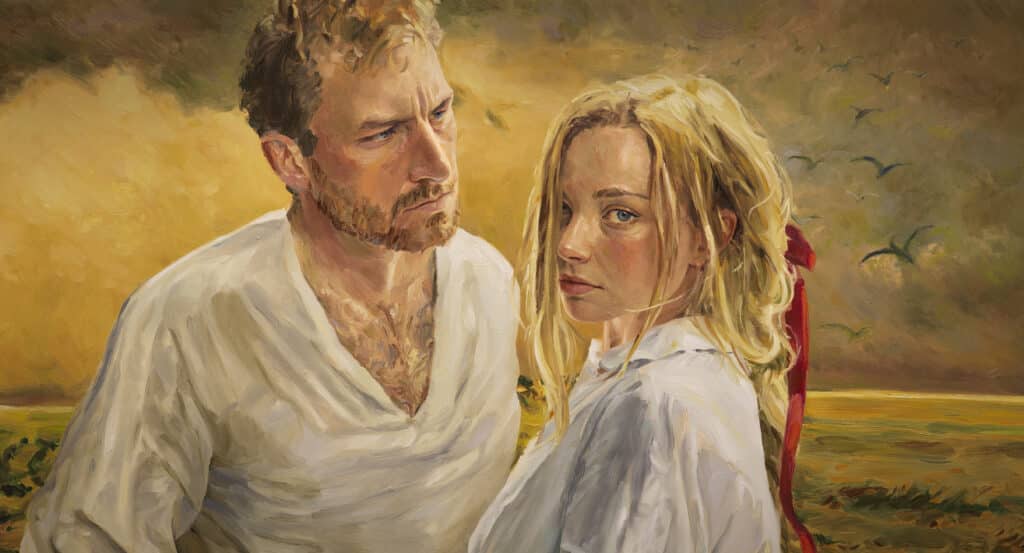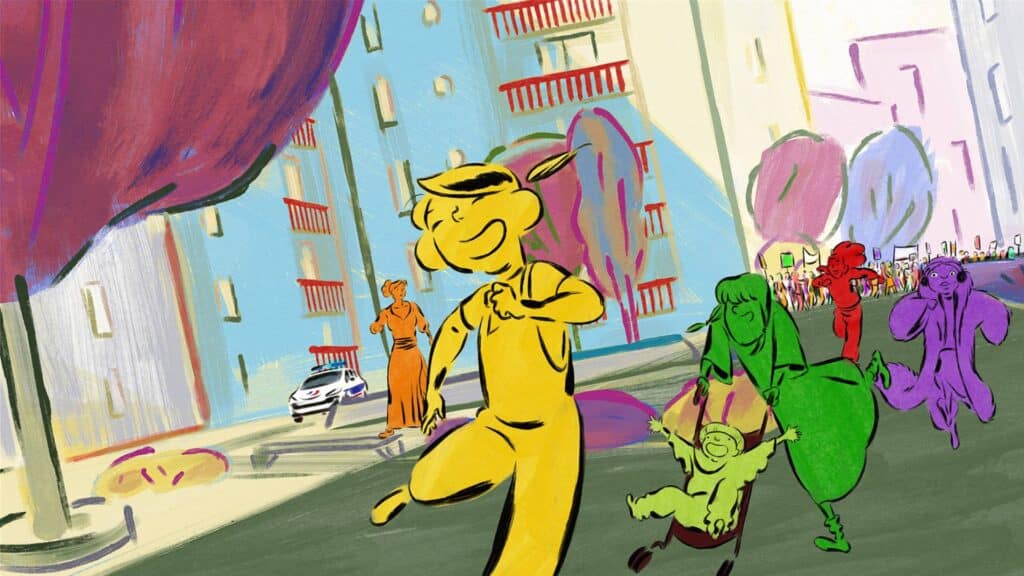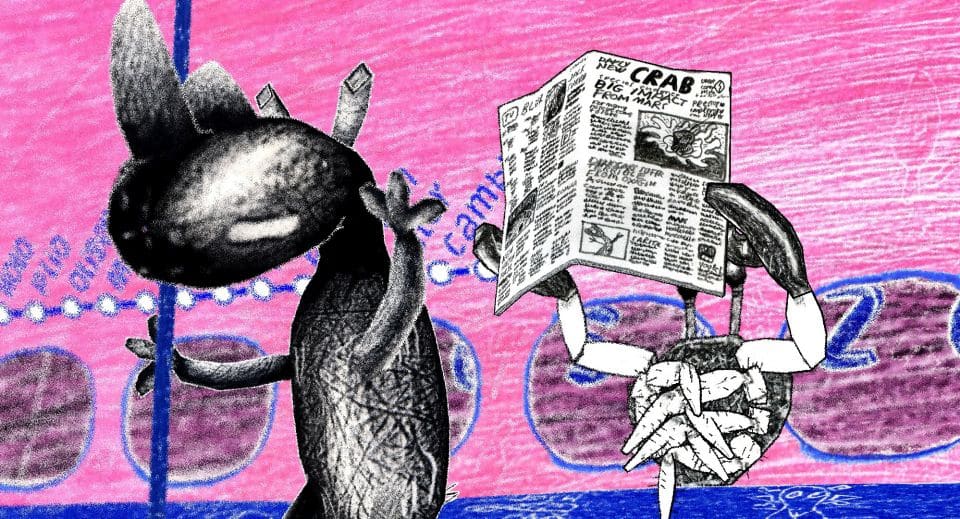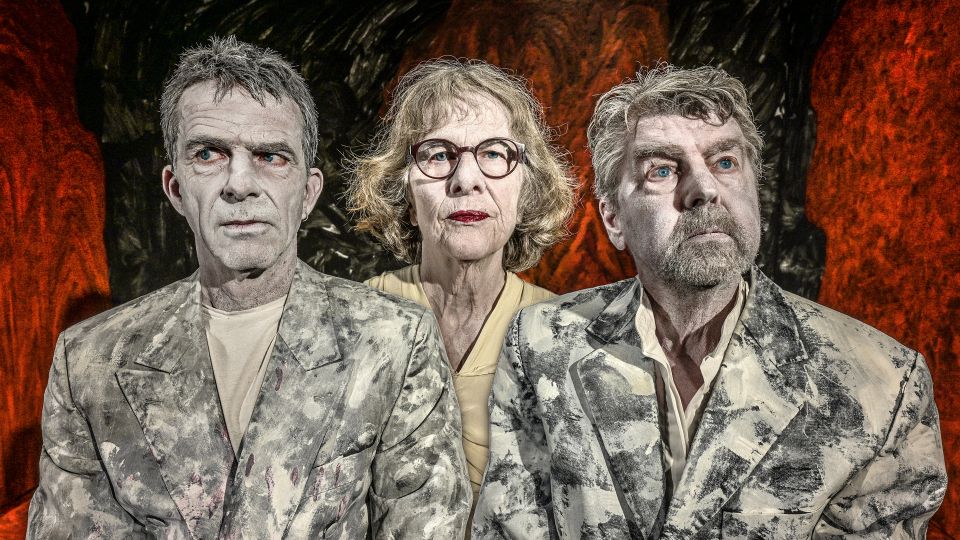Is animatie de meest veelzijdige filmvorm? Daar valt wel iets voor te zeggen. Zeker als je het caleidoscopische aanbod ziet dat het Kaboom Animation Festival weer voor ons heeft verzameld. Ook de aftrap is nogal apart. Voor de officiële opening op 5 april in Utrecht moet je niet in een filmzaal zijn. Om 20:30 sluit je je aan bij de (gratis) animatiewandeling A Wall is a Screen. Die voert langs allerlei plekken waar op muren in de stad animatiefilms worden geprojecteerd. Gezien mijn ervaring van vorig jaar wil ik dat zeker aanbevelen.
Zoals gezegd gaat het Kaboom op 5 april van start in Utrecht. Het Amsterdamse deel opent 11 april met het op Annecy en Cinekid bekroonde Chicken for Linda. Daarover straks meer. Een deel van het programma is ook online. Het persbericht belooft ons ‘De meest creatieve, vernieuwende en gedurfde (inter)nationale producties’. Veel werk in het programma is in het afgelopen animatiejaar al op diverse andere festivals in de prijzen gevallen. Ik mocht er alvast een glimp van zien, genoeg om een goede indruk van de grote veelzijdigheid van de animatiekunst te krijgen.
Olieverf

Tamelijk uniek is bijvoorbeeld de stijl van de met olieverf geschilderde animatie die de makers van Loving Vincent (2017) nu voor de tweede keer toepassen. Deze keer met The Peasants. Dit is het op een Poolse litaratuurklassieker gebaseerde drama over een boerenmeisje dat in 19e eeuw in een dorp vol afgunst en patriarchaat een eigen weg probeert te vinden. DK en Hugh Welchman draaiden de film eerst met acteurs, om daarna een internationaal team van zo’n honderd medewerkers dit beeld voor beeld in olieverf te laten overschilderen.
Je kan je bij Kaboom laten verrassen door eigenwijs handgetekend werk naast computeranimatie die toch weer anders is dan je gewend bent. Er is een soort van performance naast een ongewone documentaire. Soms is het pure grafische kunst, soms een aangrijpend verhaal. Eigenlijk laat Kaboom alles zien wat met animatie mogelijk is, behalve het al overbekende werk van Disney-Pixar.
Nederlands contrast
Om een eerste idee te krijgen van de breedte van het animatiespectrum hoef je alleen maar twee recente lange Nederlandse producties naast elkaar te zetten. De eerste is Vos en Haas redden het bos, de nieuwe film van Mascha Halberstad (Knor). De kindvriendelijke en zeer vermakelijke belevenissen van Vos, Haas, hun kleurrijke bosvrienden en de hoogst verwaande Bever. Een komedie met een ecologische boodschap. De dieren zijn weliswaar computergeanimeerd, maar staan ver af van de gladde clichéfiguren die vaak uit animatiesoftware rollen. Dit doet toch nog sterk aan stop-motion denken. Net als bij de eerdere Vos en Haas-serie zijn de figuren eerst uit klei geboetseerd en daarna ingescand in de computer. Deze opvolger van Knor ging dit voorjaar in de jeugdsectie van Berlijn in première en komt op 24 april hier in de bioscopen.
De tweede is Mechanisms Common to Disparate Phenomena #59 van Joost Rekveld, een Nederlandse kunstenaar die gefascineerd is door de interactie tussen mens en machine. Deze experimentele film beleef je als een grotendeels abstracte onderdompeling in een hypnotiserende lijnenwerveling. Allemaal gegenereerd door ouderwetse analoge computers. Je ziet hier de zogenaamde chaostheorie tot leven komen. Dat is iets te ingewikkeld om hier in twee zinnen uit te leggen, maar het maakt de ervaring niet minder fascinerend. Zeker door de toevoeging van dialoogfragmenten uit klassieke sciencefictionfilms als soundtrack. Mechanisms is een van de zeven titels van de internationale competitie lange animatie.
De vrije tekenpen

Ook daar zeer uiteenlopende animatievormen, verhalen en stijlen. Chicken for Linda, de Amsterdamse opening, is een heerlijk eigenwijs, ogenschijnlijk uit de losse pols getekend verhaal vol vaart en grappen. Een schuldbewuste moeder en haar ondeugende achtjarige dochter vinden tijdens een dwaas en toch heel herkenbaar avontuur hun onderlinge band weer terug. Opvallend is het kleurgebruik. Chiara Malta en Sebastian Laudenbach gaven ieder personage een eigen kleur op basis van hun persoonlijkheid.
Veel woester getekend is het uit de band springende western-surrealisme van Bill Plymptons Slide. Mooi contrast met de minimalistische 2D-tekenstijl van de ontroerend authentieke coming-of-age When Adam Changes van Joël Vaudreuil.
Van game-docu tot Indiase hennakunst
Ik heb niet alle competitietitels gezien, maar intrigerend vond ik zeker Knit’s Island. Een documentaire die zich afspeelt in de parallelle werkelijkheid van het survivalgame DayZ. De makers zwierven daar 963 uur rond en ontmoetten de avatars van diverse spelers. En soms laat zo’n avatar ook wel eens iets los over zijn bedenker in de echte wereld.
Zeer gecharmeerd was ik van Sultana’s Dream van Isabel Herguera. Haar hoofdfiguur Inés is ook een Spaanse animator. Op zoek naar inspiratie ontdekt ze bij toeval een in 1905 in India geschreven utopische fabel over Ladyland. Een plek waar de mannen- en vrouwenrollen geheel zijn omgedraaid. Voor de verschillende onderdelen van het verhaal creëerde Herguera verschillende animatiestijlen. Deels met sobere, met een paar lijnen neergezette figuren die toch heel levendig en expressief zijn. Maar ook met heel rijk vormgegeven taferelen, in fraaie grafische cutout-techniek naar de tradtitonele henna-kunst. Het past op een heel organische manier bij elkaar en is een prachtige manier om het karakter van dit filosofische, en nooit moralistische verhaal te versterken.
De signatuur van De Beijer en De Nooijer
Kunstenaars kunnen animatie op allerlei manieren naar hun hand zetten. Vooral kort werk, dat bij Kaboom overvloedig aanwezig is, geeft veel vrijheid. Ter illustratie twee Nederlandse namen waar Kaboom speciaal plaats voor maakt: Evert de Beijer, en het vader-zoon duo Paul & Menno de Nooijer.

De in januari van dit jaar overleden De Beijer was een van de meest bevlogen Nederlandse animatoren. Zijn werkwijze noemde hij zelf een designavontuur. “Ik wil altijd iets nieuws uitproberen. Ik vind dat het grafisch ontwerp voor een animatiefilm deel van het amusement is.” Inderdaad straalt het ontwerpplezier van al zijn werk af. Of het nu het amoureuze koppel in De karakters is, dat verwikkeld raakt in een bizarre rondedans met tot leven gekomen letters en teksten, of de heerlijk grillige figuren in Lucy, over een puber die via een trap in een museum afdaalt in de spelonken van de prehistorische tijd. De karakters werd door Holland Animation uitgeroepen tot beste Nederlandse animatiefilm van de 20ste eeuw.

Volstrekt anders, maar met een even duidelijke persoonlijke signatuur, is het werk van Paul de Nooijer en zijn zoon Menno. Korte films waarin ze zelf vaak optreden en waarin de grenzen tussen film, fotografie, animatie en performance vervagen. Vol energie, uitdagende trekjes, humor en in de laatste werkstukken ook melancholie. Paul kreeg een aantal jaren geleden de diagnose prostaatkanker. Met name het vorig jaar voltooide Is Heaven Blue #2 is een creatie die tegelijkertijd experimenteel en zeer intiem en persoonlijk is. Het ademt in alles een sfeer van afscheid. Met Paul zelf, zijn vrouw en zoon, in hun gezamenlijke verbeelding van allerlei aspecten van het leven. Nog steeds met een soort mengeling van verbazing en koppigheid, soms rauw en aangrijpend, dan weer heel speels. Een soort creatieve dans die toewerkt naar een eindbeeld dat mij diep ontroerde.
online. Naast de in dit artikel genoemde onderdelen zijn er ook een competitie korte films, een VR-programma, verschillende specials waaronder Poolse animatie en animatie van Iraanse vrouwen, diverse talks, een masterclass van de Ierse animator en striptekenaar Tomm Moore (The Secret of Kells), een panel samen met Omroep Zwart rond de visualisatie van het moeder-zijn, een kinderprogramma en meer.
Drie titels die na Kaboom in de loop van april in de bioscoop uitgaan zijn Vos en Haas redden het bos, The Peasants en They Shot the Piano Player.
